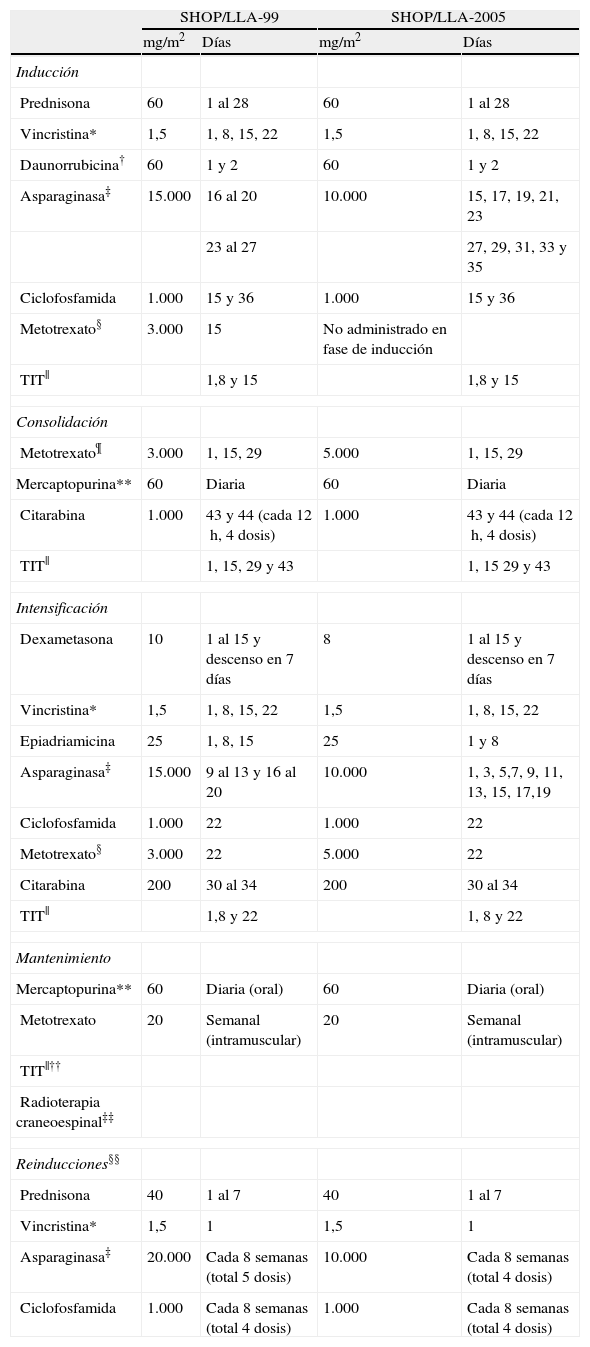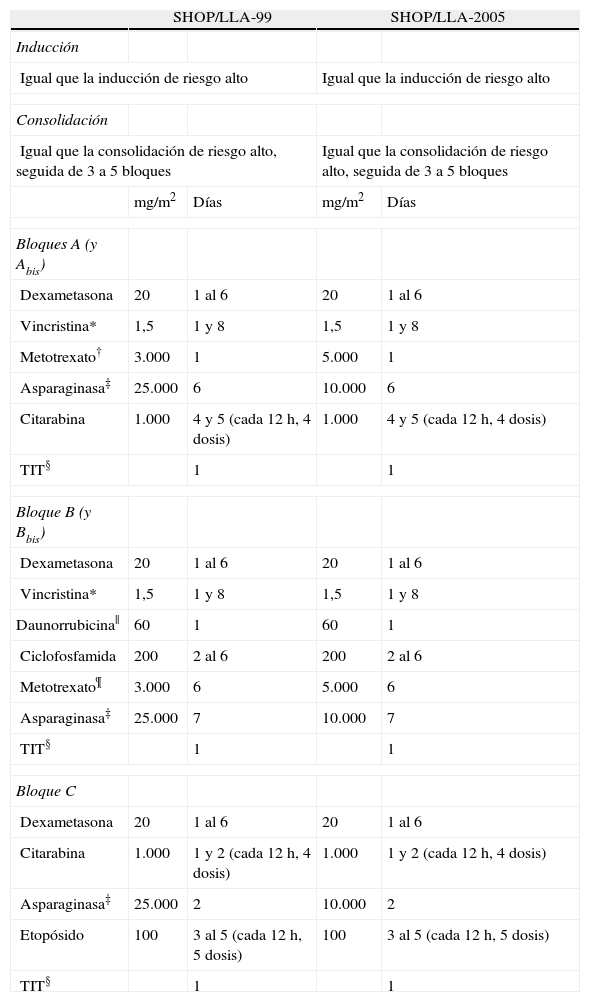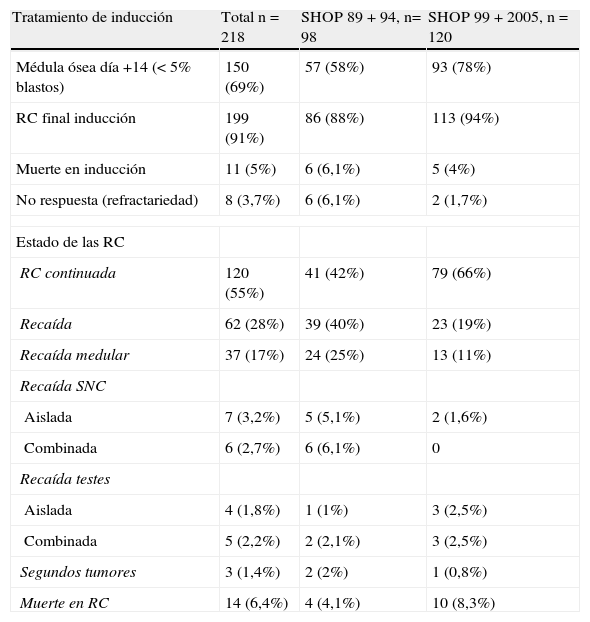La leucemia linfoblástica aguda (LLA) es el cáncer más frecuente en la edad pediátrica, con tasas de curación del 80-85%. En la LLA de fenotipo T (LLA-T, 15% de casos) los factores pronósticos no están bien definidos. Nuestro objetivo es analizar la supervivencia y los factores pronósticos clínicos en una serie de pacientes con LLA-T.
Pacientes y métodoSe analizaron los niños con LLA-T (1-18 años) tratados según los protocolos SHOP/LLA-89/LLA-94/LLA-99/LLA-2005 (desde febrero de 1989 hasta noviembre de 2009) en 37 instituciones.
ResultadosSe incluyeron 218 pacientes con LLA-T sobre un total de 1.652 LLA pediátricas. De ellos, 164 (75%) eran varones. La edad mediana fue de 7,8 años (extremos 1,3-18,6). La mediana de leucocitos fue 78,2×109/l (extremos 0,8-930). Quince niños (6,8%) tuvieron infiltración del sistema nervioso central (SNC). En cuanto a la respuesta al tratamiento de inducción, 150 (75%) pacientes tenían menos de 5% de blastos en médula ósea del día +14 y 199 alcanzaron la remisión completa. La supervivencia global (SG) media (DE) a 60 meses para los protocolos SHOP/LLA-89, LLA-94 y LLA-99 fue del 48 (8), 49 (6) y 70 (6) %, respectivamente, y la SG a 48 meses para el protocolo SHOP/LLA-05 (protocolo en curso) del 74 (8) %. La mediana de seguimiento fue de 206, 152, 74 y 17 meses, respectivamente. El análisis de factores pronósticos no mostró diferencias significativas en cuanto a sexo ni edad. Resultaron significativos la cifra de leucocitos mayor o igual a 200×109/l (p=0,024), la infiltración del SNC al diagnóstico (p<0,006), la respuesta al tratamiento (médula ósea día +14) (p=0,005) y la remisión completa al final de la inducción (p=0,0000).
ConclusionesLos resultados obtenidos en la LLA-T con los protocolos SHOP/LLA-89 y SHOP/LLA-94 fueron inferiores a otros protocolos contemporáneos, pero la supervivencia mejoró en los 2 últimos protocolos. En concordancia con otras series de LLA-T, la respuesta al tratamiento fue el principal factor pronóstico.
Acute lymphoblastic leukemia (ALL) is the most frequent cancer in childhood, with cure rates of 80-85%. In T-cell ALL (15% of ALL), prognostic factors are ill defined. We aimed to describe the event-free survival (EFS) and analyze clinical prognostic factors in a series of pediatric T-ALL of 4 consecutive clinical trials.
Patients and methodsChildren with T-ALL aged 1-18 years treated in 37 institutions in Spain were enrolled in 4 consecutive trials from February-1989 to November-2009.
ResultsA total of 218 T-ALL patients out of 1,652 pediatric ALL were evaluable during the study period (SHOP/ALL-89: 35, ALL-94: 63, ALL-99: 62, ALL-2005: 58). There were 164 boys (75%). Median age (years) was 7.8 range (1.3-18.6). Median leukocytes (109/L) was 78.2, range 0.8-930. Fifteen (6.8%) children had central nervous system (CNS) involvement at diagnosis. Regarding response to induction treatment, 150 (75%) patients had less than 5% blasts on day-14 bone marrow and 199 achieved complete remission at the end of induction. Overall survival (OS) at 60 months for SHOP/ALL-89, ALL-94, ALL-99 was 48 (8), 49 (6), 70 (6) %, respectively, and at 48 months for SHOP/ALL-2005 (ongoing protocol) was 74 (8) %. Median follow-up (months) was 206, 152, 74 and 17 respectively. Analysis of prognostic factors revealed no statistical differences regarding sex or age. Leukocyte count over 200×109/l (P=.024), CNS infiltration at diagnosis (P<.006) and treatment response had prognostic significance (end-induction complete remission) (P=.0000), day 14-bone marrow (P=.005).
ConclusionsResults for the SHOP/ALL-89 and ALL-94 protocols were inferior to other contemporary protocols but there has been an improvement in survival in the 2 last trials. In line with other T-ALL series, response to treatment had the strongest prognostic impact.
Artículo
Comprando el artículo el PDF del mismo podrá ser descargado
Precio 19,34 €
Comprar ahora












